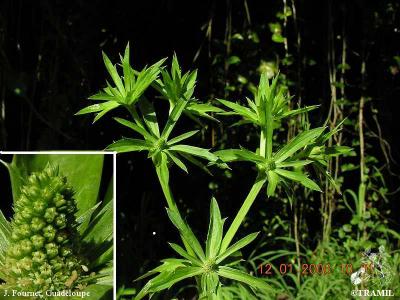(In territories with significant traditional TRAMIL use)
Trinidad and Tobago:
- chadwon beni
- fit weed
Martinique:
- chadwon beni
- fit weed
Dominica:
- chadwon beni
- fit weed
Dominican Republic:
- cilantro ancho
- koulant
Honduras:
- culantro
Costa Rica:
- culantro de coyote
- spirit weed
Haiti:
- koulant
leaf, decoction, orally1
The use for chest pain and attacks, palpitations and tiredness is classified as REC based on the significant traditional use documented in TRAMIL surveys and toxicity studies. We do not have an appropriate experimental model to validate the pharmacological activity to support this traditional use.
If deterioration is observed in the patient or if the chest pain, attacks, palpitations or tiredness persist for more than 7 days, seek medical attention.
The use for fever is classified as REC based on the significant traditional use documented in the TRAMIL surveys and the toxicity and validation studies.
If deterioration is observed in the patient or the fever persists for more than 2 days, seek medical attention.
The use for flatulence, flu and vomiting is classified as REC based on the significant traditional use documented in TRAMIL surveys and toxicity studies.
If deterioration is observed in the patient or the flu persists for more than 7 days, or the vomiting persists for more than 2 days, seek medical attention.
Use for flatulence, flu and vomiting is classified as REC based on the significant traditional use documented in TRAMIL surveys and toxicity studies.
If deterioration is observed in the patient or the flu persists for more than 7 days, or the vomiting persists for more than 2 days, seek medical attention.
Not for use during pregnancy, breastfeeding or in children under 3 years.
The Eryngium foetidum leaf is a condiment of relatively widespread human consumption.
For all uses:
prepare a decoction or infusion with 20- 30 grams of leaves in 4 cups (1 litre) of water. For decoction, boil for 5 minutes in a covered vessel. For the infusion, add the boiling water to the 20-30 grams of leaves and cover. Leave to stand for 5 minutes, cool, strain (filter) and drink 1 cup 3 times a day.
Preparations must never be stored for more than 24 hours, even if refrigerated.
1 OCAMPO R, 1988
Encuesta TRAMIL (Costa atlántica), Instituto de Desarrollo Agrario, Universidad de Costa Rica, San José, Costa Rica.
2 CHARLES C, 1988
TRAMIL survey. Movement for Cultural Awareness MCA, Roseau, Dominica.
3 JEAN-PIERRE L, 1988
TRAMIL survey. St. Lucia National Herbarium, Castries, St. Lucia.
4 LONGUEFOSSE JL, NOSSIN E, 1990-95
Enquête TRAMIL. Association pour la valorisation des plantes médicinales de la Caraïbe AVPMC, Fort de France, Martinique.
5 DELAIGUE J, 2005
TRAMIL survey. PRDI, Tobago House of Assembly, Scarborough, Tobago.
6 GERMOSEN-ROBINEAU L, GERONIMO M, AMPARO C, 1984
Encuesta TRAMIL. enda-caribe, Santo Domingo, Rep. Dominicana.
7 LAGOS-WITTE S, 1988-1995
Encuestas TRAMIL. Laboratorio de Histología Vegetal y Etnobotánica, Departamento de Biología, Universidad Nacional Autónoma de Honduras UNAH, Tegucigalpa, Honduras.
8 WENIGER B, 1987-88
Encuesta TRAMIL. enda-caribe, Santo Domingo, Rep. Dominicana.
9 FORGACS P, JACQUEMIN H, MORETTI C, PROVOST J, TOUCHE A, 1983
Etude phytochimique et activités biologiques de 18 plantes de la Guyane Française. Plantes Médicinales Phytothér 17(1):22-32.
10 WONG K, FENG M, SAM T, TAN G, 1994
Composition of the leaf and root oils of Eryngium foetidum L. J Essent Oil Res 6(4):369-374.
11 MUNSELL H, WILLIAMS LO, GUIL LP, TROESCHER CB, NIGHTINGALE G, HARRIS RS, 1950
Composition of food plants of Central America. IV: El Salvador. Food Res 15(4):263-296.
12 ARBAIN D, CANNON JR, AFRIASTINI, KARTAWINATA K, DJAMAL R, BUSTARI A, DHARMA A, ROSMAWATY H, SJAFAR M, SJAIFUL, NAWFA R, KOSELA S, 1989
Survey of some West Sumatran plants for alkaloids. Econ Bot 43(1):73-78.
13 HERRERA J, 1992
Determinación de parámetros farmacológicos usados en medicina tradicional popular en la Cuenca del Caribe. Departamento de Farmacología, Facultad de Salud, Universidad del Valle, Cali, Colombia.
14 SARAVIA A, 1992
Estudios sobre plantas TRAMIL. Departamento de Farmacología, Universidad de San Carlos, Guatemala, Guatemala.
15 GARCIA D, SAENZ T, 1995
Toxicidad aguda de algunas plantas TRAMIL. Informe TRAMIL. Farmacognosia, Facultad de Farmacia, Universidad de Sevilla, Sevilla, España.
16 SAENZ MT, FERNANDEZ MA, GARCIA MD 1997
Anti-inflammatory and analgesic properties from leaves of Eryngium foetidum L. (Apiaceae). Phytother Res 11:380-383.
17 SIMON O, SINGH N, 1986
Demonstration of anticonvulsant properties of an aqueous extract of spirit weed (Eryngium foetidum). Wi Med J 35(2):121-125.
18 SAUVAIN M, 1989
Etude des plantes antiparasitaires du plancton des Guyanes en Amazonie : antipaludiques et antileishmanioses (Thèse de Doctorat). Université Paris-Sud, Paris, France.
19 CACERES A, SAMAYOA B, 1989
Tamizaje de la actividad antibacteriana de plantas usadas en Guatemala para el tratamiento de afecciones gastrointestinales. Guatemala, Guatemala: Dirección General de Investigaciones, Universidad de San Carlos (DIGI-USAC).
20 GARCIA GM, COTO MT, GONZALEZ CS, PAZOS L, 1996
Toxicidad sub-crónica, en ratones, del extracto acuoso de la planta entera de Eryngium foetidum. Informe TRAMIL. Laboratorio de Ensayos Biológicos LEBi, Escuela de Medicina, Universidad de Costa Rica, San Pedro, Costa Rica.
21 PAZOS L, COTO T, GONZALEZ S, QUIROS S, 2004
Toxicidad oral, subcrónica en ratones, dosis repetidas, del extracto acuoso de planta entera de Eryngium foetidum. Informe TRAMIL. Laboratorio de Ensayos Biológicos LEBi, Escuela de Medicina, Universidad de Costa Rica, San Pedro, Costa Rica.


